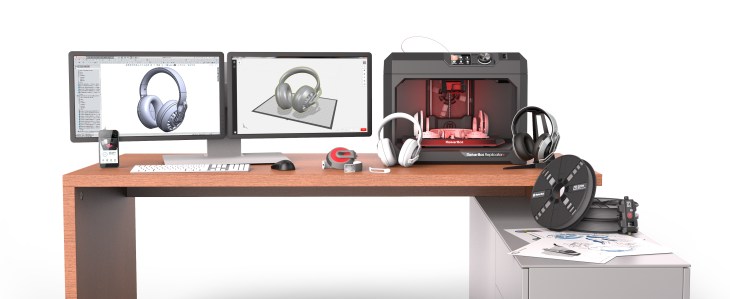The other week, I spoke with the new CEO of 3D Systems. He told me that he believes the consumer 3D printing business “is not real.” That’s not exactly the vote of confidence one is looking for when talking to the head of the company that more or less created the space three decades back.
And indeed, it’s been tough going, of late. The once hyped technology has taken a pretty big hit recently, and MakerBot, its self-stylized poster child, has absorbed a lot of that blow. The last couple of years have been peppered with stories about bad earnings reports, layoffs, and a parent company that seemingly paid for the company at its peak.
This morning, CEO Jonathan Jaglom (who took the helm of the company last February) headed up a press conference at the startup’s downtown Brooklyn offices to layout MakerBot’s plan for the future. The list features two new printers, the MakerBot Replicator+ and MakerBot Replicator Mini+ — though, interestingly, in its own press material, the company didn’t exactly focus on its new devices, as evidenced by the header, “MakerBot Launches New 3D Printing Solutions for Professionals and Educators.”
That marks something of a shift for a company that has traditionally been hardware focused, born out of the hackerspace RepRap project. The Replicator+ and Replicator Mini+ names are indicators that the new printers are more upgrades that full refreshes – but there are some pretty interesting enhancements on board that offer some indication of the direction in which the company is headed.
The Replicator+ has the sorts of upgrades one would expect – it’s got a 25-percent larger build volume and a 30-percent increase in print speeds. The printer is capable of finer prints than its predecessor and adopts the Smart Extruder print head that was announced in January as an upgrade to its 5th generation products, bringing more reliable prints to what has traditionally been a key failure point.
The Replicator Mini+, meanwhile, maintains the company’s focus on education. Along with the standard Replicator, the new Mini is quieter than its predecessor – 58-percent in this case, definitely a key upgrade for the classroom setting. The new Mini is also 10-percent faster than the last version. The printer will be coupled with a new educational vertical in the company’s Thingiverse online print community.
The other key aspect to all of this is price. The Replicator+ is $1,999 and the Mini+ is $999 (at least through the end of October, at which point prices will jump by a few hundred bucks) suggesting that the company is looking to stay competitive with players like XYZ, which have drastically undercut the consumer 3D printer price point.
Here’s Jaglom on today’s news, “We have gone through a cultural shift here at MakerBot over the past year, where listening and understanding the needs of our customers are cornerstones of our company. As a result, we’ve gained an in-depth understanding of the wider needs of professionals and educators that has informed our product development process.”
